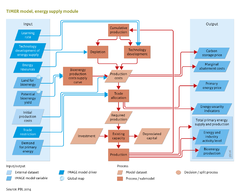Energy supply: Difference between revisions
Jump to navigation
Jump to search
No edit summary |
Oostenrijr (talk | contribs) No edit summary |
||
| Line 10: | Line 10: | ||
Depletion is a function of either cumulative production or annual production. For example, for fossil-fuel resources and nuclear feedstock, low-cost resources are slowly being depleted, and thus higher cost resources need to be used. In annual production, for example, of renewables, attractive production sites are used first. Higher annual production levels require use of less attractive sites with less wind or lower yields. | Depletion is a function of either cumulative production or annual production. For example, for fossil-fuel resources and nuclear feedstock, low-cost resources are slowly being depleted, and thus higher cost resources need to be used. In annual production, for example, of renewables, attractive production sites are used first. Higher annual production levels require use of less attractive sites with less wind or lower yields. | ||
It is assumed that all demand is always met. Because regions are usually unable to meet all of their own demand, energy carriers, such as coal, oil and gas, are widely traded. The impact of depletion and technology development lead to changes in primary fuel prices, which influence investment decisions in the end-use and energy-conversion modules Linkages to other parts of IMAGE framework include available land for bioenergy production, emissions of greenhouse gases and air pollutants (partly related to supply), and the use of land for bioenergy production (land use for other energy forms are not taken into account). Several key assumptions determine the long-term behaviour of the various energy supply submodules and are mostly related to technology development and resource base. | It is assumed that all demand is always met. Because regions are usually unable to meet all of their own demand, energy carriers, such as coal, oil and gas, are widely traded. The impact of depletion and technology development lead to changes in primary fuel prices, which influence investment decisions in the end-use and energy-conversion modules Linkages to other parts of IMAGE framework include available land for bioenergy production, emissions of greenhouse gases and air pollutants (partly related to supply), and the use of land for bioenergy production (land use for other energy forms are not taken into account). Several key assumptions determine the long-term behaviour of the various energy supply submodules and are mostly related to technology development and resource base. | ||
|ComponentCode=ES | |ComponentCode=ES | ||
|AggregatedComponent=Energy supply and demand | |AggregatedComponent=Energy supply and demand | ||
|FrameworkElementType=pressure component | |FrameworkElementType=pressure component | ||
}} | }} | ||
Revision as of 15:18, 1 July 2014
| Component is implemented in: |
|
| Related IMAGE components |
| Projects/Applications |
| Key publications |
Key policy issues
- How can energy resources be exploited to meet future primary energy demand?
- How can energy supply and demand be balanced between world regions, and how will this effect security of supply?
- How rapidly can the transition to more sustainable energy supply be made?
